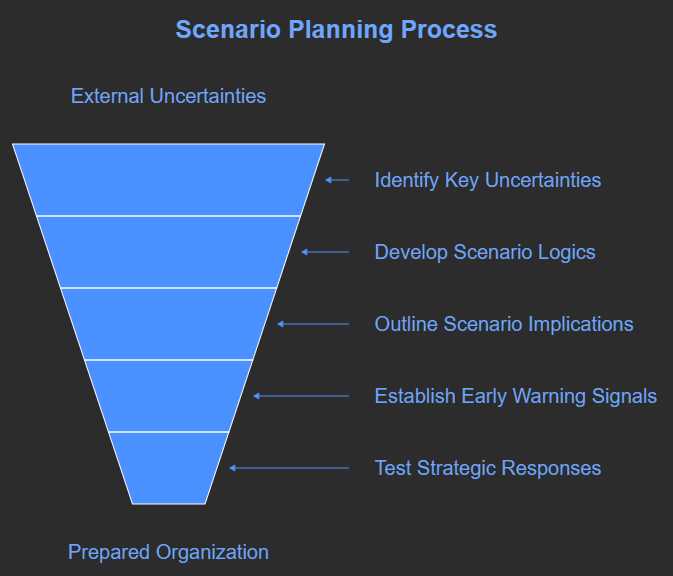Exploring Options: How Scenario Planning Helps You Find Alternatives
As we face an ever-changing world, it’s important to consider the different paths ahead. Scenario planning is a tool that can help us explore various options and anticipate potential outcomes. By looking at different possibilities, we can be better prepared to make informed decisions and adapt to whatever the future may hold.
In this article, we’ll explore how scenario planning can help individuals and organizations find alternatives and navigate uncertainty.
What is Scenario Planning?
Basics of Preparing for the Future
Amidst the uncertainty brought about by the COVID-19 pandemic and recent political unrest, scenario planning has become increasingly important for organizations seeking to navigate an uncertain future. Scenario planning is a structured process for making strategic decisions in uncertain futures. It typically involves sketching out multiple external scenarios and identifying internal actions to prepare for and respond to them.
Two effective scenario planning methods have been highlighted as particularly useful. The Management Center’s “5-Box Scenario Planning Tool” offers a scalable process focused on constructing key assumptions and impacts for each scenario. Another method by Bridgespan provides a more nuanced framework, considering key factors and outlining actions in three categories appropriate for different scenarios.
A customized, more detailed scenario planning process would be necessary for large, complex organizations, involving considerations specific to the organization’s needs and complexities. Different effective methods and levels of detail for scenario planning are available, each suited for specific organizational contexts.
The History of Scenario Planning
Scenario planning has a rich history dating back to the 1950s, when it was first utilized by the military as a way to anticipate alternative strategies and prepare for potential future conflicts. Over time, scenario planning has evolved to become a widely adopted strategic tool across various industries, including business, public policy, and non-profit organizations.
For example, in the 1970s, Royal Dutch Shell famously used scenario planning to navigate the oil crisis and anticipate different potential futures for the energy industry. This allowed the company to make strategic decisions that positioned them favorably in a rapidly changing market.
Similarly, in the 2000s, scenario planning was employed by healthcare organizations to prepare for potential pandemics, leading to improved response capabilities during the H1N1 outbreak.
As Dave Algoso highlights, scenario planning’s history demonstrates its adaptability and effectiveness in helping organizations navigate uncertainty. By learning from the past, organizations can better prepare for an unpredictable future.
For further details on the historical evolution of scenario planning, organizations should look to documented case studies that illustrate its application in different contexts.
Why Use Scenario Planning Alternatives?
Benefits of Exploring Different Outcomes
One significant benefit of exploring different outcomes in scenario planning is the ability to develop strategic responses to unpredictable situations. By considering multiple potential future scenarios, organizations can identify early signals and better prepare for various possibilities. For example, a retail company might use scenario planning to anticipate shifts in consumer behavior, such as increased online shopping or decreased in-store foot traffic. This allows them to develop proactive strategies to address these potential changes, such as investing in e-commerce platforms or adjusting store layouts to accommodate social distancing measures.
Exploring different outcomes can also help organizations avoid being blindsided by unexpected events. For instance, a manufacturing company might use scenario planning to prepare for supply chain disruptions due to natural disasters or geopolitical tensions. By considering these possibilities, they can develop contingency plans and build resilience into their operations to mitigate potential disruptions.
Overall, exploring different outcomes in scenario planning enables organizations to be more proactive, agile, and resilient in the face of uncertainty, ultimately improving their ability to navigate complex and unpredictable environments.
Title: The Advantages of Considering Different Scenarios
Success Stories: Businesses That Thrived
Business Success Stories Amidst Uncertainty
Amidst the uncertain landscape of global events such as the COVID-19 pandemic and recent political unrest, businesses have thrived through effective scenario planning. For instance, a retail company swiftly shifted its focus to e-commerce and experienced tremendous growth in online sales. Another success story involves a restaurant chain that implemented innovative delivery and takeout options, maintaining revenue streams amidst dining restrictions. In both cases, these businesses made strategic decisions based on scenario planning amidst uncertain futures.
These examples illustrate the practical application of scenario planning in navigating uncertain times for businesses. Rather than succumbing to fear, these companies utilized scenario planning to identify potential scenarios and prepare appropriate internal actions. By doing so, they were able to not only survive but also thrive in the face of unprecedented challenges.
How to Identify Scenario Planning Alternatives
Mapping the Possibilities – Efficient Methods for Scenario Planning in Uncertain Times
In the context of scenario planning alternatives, organizations must map out the possibilities brought about by unpredictable events such as the COVID-19 pandemic and political unrest. Scenario planning enables organizations to identify potential challenges and opportunities that may arise from different future scenarios, allowing them to make strategic decisions to adapt and thrive in uncertain times.
Practical examples of effective scenario planning methods include the “5-Box Scenario Planning Tool” by the Management Center. This scalable process helps organizations construct key assumptions and impacts for each scenario. Another method by Bridgespan offers a more nuanced framework, considering key factors and outlining actions in three categories appropriate for different scenarios. Additionally, large, complex organizations may require customized, detailed scenario planning processes to address their specific needs and complexities.
Evaluating Impact and Likelihood in Scenario Planning Alternatives
When considering scenario planning alternatives, evaluating the impact and likelihood of different scenarios is a critical step. This involves assessing the potential consequences of each scenario and the probability of it occurring. For example, in the context of the COVID-19 pandemic, companies could evaluate the impact of prolonged supply chain disruptions on their business operations and the likelihood of such disruptions happening again in the future.
One practical example of evaluating impact and likelihood is using historical data to assess the potential impact of similar past events and the likelihood of them recurring. Additionally, conducting market research and consulting with industry experts can provide valuable insights into potential scenarios and their respective impact and likelihood.
Another approach is to conduct scenario workshops involving key stakeholders, where different scenarios are discussed, and impact and likelihood are evaluated collectively. This allows for a more comprehensive and diverse assessment of potential scenarios.
Scenario Planning in Action
Lessons Learned from Real-World Application
Scenario planning has proven to be an invaluable tool for organizations navigating uncertain and tumultuous times, such as those brought about by the COVID-19 pandemic and recent political upheaval. The real-world application of scenario planning methods has highlighted the importance of preparing for a range of potential futures and identifying internal actions to respond effectively.
For example, the “5-Box Scenario Planning Tool” offers a structured and scalable approach for organizations to consider key assumptions and impacts for each scenario, allowing for the development of targeted strategies. Similarly, the method by Bridgespan provides a more nuanced framework, outlining specific actions suitable for different scenarios based on key factors.
These real-world examples underscore the need for organizations to invest in scenario planning processes tailored to their specific needs and complexities. For large, complex organizations, a customized and detailed scenario planning approach, as advocated by BCG, is essential for long-term resilience and adaptability.
Tools and Techniques for Scenario Planning
Software and Models to Help You Plan – The Scenario Planning Toolbox
In today’s unpredictable environment, scenario planning has become an indispensable tool for organizations seeking to navigate uncertainty and plan for the future. One valuable resource is the “5-Box Scenario Planning Tool,” which guides users through the process of outlining key assumptions and impacts for multiple potential scenarios. This structured approach helps organizations identify and prepare for various future possibilities, ensuring they are not caught off guard by unexpected developments.
Another effective method highlighted by Dave Algoso is the comprehensive framework offered by Bridgespan. This method considers a range of key factors and outlines specific actions tailored to different potential scenarios. By addressing a variety of internal and external variables, organizations can prepare for a wide array of future challenges.
For large, complex organizations, a more detailed, customized scenario planning process may be necessary. This may involve considerations like those presented in a resource from BCG, catering to the specific needs and complexities of the organization.
By utilizing these tools and models to guide scenario planning efforts, organizations can gain valuable insights and develop proactive strategies to face an uncertain future with confidence.
Practical Steps to Create Scenarios

When initiating scenario planning in response to uncertain global events, organizations can follow these practical steps to create effective scenarios:
- Identify key uncertainties: Begin by pinpointing external factors that could significantly impact the organization, such as economic trends, technological advancements, or political developments.
- Develop scenario logics: Create distinct narrative storylines for potential future developments based on the identified uncertainties, considering a range of best-case and worst-case scenarios.
- Outline scenario implications: Map out the potential implications of each scenario on the organization, including financial impacts, operational changes, and resource allocation.
- Establish early warning signals: Define measurable indicators that would signal the emergence of each scenario, enabling proactive adjustments and preparations.
- Test strategic responses: Develop and assess a set of strategic actions tailored to address each scenario, ensuring the organization is prepared to pivot effectively in response to unfolding developments.
By following these practical steps, organizations can proactively navigate uncertainty and build resilience to external shocks, positioning themselves to thrive in an ever-changing landscape.
Common Challenges in Scenario Planning

Overcoming Obstacles – Adapting to Uncertainty: Alternative Approaches to Scenario Planning
Scenario planning is a valuable tool for organizations navigating uncertain times, such as those brought about by the COVID-19 pandemic and recent political unrest. Instead of adopting a one-size-fits-all approach, organizations can explore alternative methods to scenario planning to overcome obstacles and prepare for the unknown.
For instance, some organizations find the “5-Box Scenario Planning Tool” by the Management Center effective due to its scalable process, which allows them to construct key assumptions and impacts for each scenario. On the other hand, the method by Bridgespan offers a more detailed framework, outlining actions in three categories suitable for different scenarios.
Moreover, large and complex organizations may require a customized scenario planning process, taking into account specific considerations like those presented in a resource from BCG. By exploring these alternative approaches, organizations can tailor their scenario planning to their unique needs and complexities, ultimately helping them overcome obstacles in an uncertain environment.
Adapting to Change in Real Time – Reactive Response Strategies for Uncertain Futures
Organizations must be prepared to adapt to change in real time. Scenario planning is an effective tool for this, enabling strategic decision-making in the face of uncertain futures.
For example, during the COVID-19 pandemic, businesses rapidly adapted to scenarios where in-person interactions were limited, shifting to online operations and remote work. Similarly, recent political unrest necessitated quick changes in security and crisis management protocols for companies operating in affected regions. These real-world examples demonstrate the practical value of scenario planning in preparing for and responding to external events.
Effective scenario planning methods, such as the “5-Box Scenario Planning Tool” and the framework offered by Bridgespan, provide scalable and nuanced approaches to identify key assumptions, impacts, and actions for various scenarios. Large organizations may require more customized, detailed scenario planning processes to suit their specific needs and complexities, as highlighted by a resource from BCG. By actively engaging in scenario planning, organizations can proactively navigate uncertain futures, enabling them to react swiftly and effectively to unexpected changes.
Making Decisions Using Scenario Planning Alternatives

Choosing the Best Path Forward
When facing uncertainty, organizations must carefully consider the best path forward. Scenario planning offers a structured process for making strategic decisions in the midst of uncertain futures. Two effective methods include the “5-Box Scenario Planning Tool” by the Management Center and a more nuanced framework by Bridgespan.
The former focuses on constructing key assumptions and impacts for each scenario, while the latter considers key factors and outlines actions in three categories appropriate for different scenarios. For large, complex organizations, a customized, more detailed scenario planning process may be necessary, involving considerations like those presented in a resource from BCG.
For example, a retail company may use scenario planning to prepare for various potential outcomes of the COVID-19 pandemic, such as prolonged closures, supply chain disruptions, or changes in consumer behavior. Similarly, a healthcare organization may utilize scenario planning to anticipate the impacts of political unrest on access to healthcare services and funding.
When to Revisit and Revise Scenarios
In the realm of scenario planning, it’s important to periodically revisit and revise scenarios to ensure their continued relevance and effectiveness. With the ever-changing global landscape, scenarios that were once considered are no longer applicable, making it imperative to update them.
For example, a scenario envisioning a rapid economic recovery post-COVID-19 might need to be revised as new information emerges about the long-term impact on industries and consumer behavior. Similarly, a scenario anticipating stable political conditions might need to be revisited in light of recent unrest or changes in government leadership.
Regularly revisiting and updating scenarios allows organizations to stay ahead of potential risks and capitalize on emerging opportunities, ensuring that their strategic responses remain well-informed and effective. This process is particularly beneficial for organizations facing uncertainty, such as those in highly regulated industries or global supply chains.
Adapting scenario planning methodologies, such as the “5-Box Scenario Planning Tool” or the framework offered by Bridgespan, to accommodate changing external factors and internal capabilities is essential to navigate an uncertain future effectively. Customized, detailed scenario planning processes may also be necessary for large, complex organizations with specific needs and complexities.

Vizologi is a revolutionary AI-generated business strategy tool that offers its users access to advanced features to create and refine start-up ideas quickly.
It generates limitless business ideas, gains insights on markets and competitors, and automates business plan creation.


